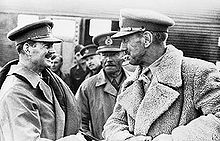- Michael Gambier-Parry
-
Michael Gambier-Parry Born 21 August 1891 Died 1976 Allegiance  United Kingdom
United KingdomService/branch  British Army
British ArmyYears of service 1911 - 1944 Rank Major General Commands held Malaya Infantry Brigade
2nd Armoured DivisionAwards Military Cross Major General Michael Denman Gambier-Parry MC DL (21 August 1891 - 1976) was a British Army officer who commanded 2nd Armoured Division.
Contents
Early life and family
The Gambier-Parry’s of Highnam Court, Gloucestershire; were an artistic and military family, (see Thomas Gambier Parry). Michael's father Ernest[1], was a major in the army sent to Egypt to avenge the death of General Gordon, and wrote a book (Suakin, 1885) about his experiences. Michael Denman Gambier-Parry joined the Royal Welch Fusiliers like his father before.
Military career
Gambier-Parry was commissioned, a Captain into the Royal Welch Fusiliers in 1911.[2] He served in World War I in France (awarded the Military Cross) and in the Gallipoli Campaign and then in Mesopotamia.[2] He transferred to the Royal Tank Corps in 1924 and then served as a General Staff Officer at the War Office before becoming Commander of the Malaya Infantry Brigade in 1938.[2]
He served in World War II as Head of the British Military Mission to Greece in 1940 and then as General Officer Commanding 2nd Armoured Division[3] in North Africa before becoming a Prisoner of war in 1941.[2]
He was captured with Brigadier Vaughan at Mechili in April 1941. Arriving in Villa Orsini near Sulmona with Philip Neame, Richard O'Connor, John Combe and George Younghusband, he was sent to Castello de Vincigliata PG12 near Florence the same year. As Carton de Wiart wrote of him "…he was also a most gifted man, made delightful sketches, was a first class 'forger' – which could no doubt earn him a steady income in the underworld".[4] [5] Known as 'GP', he was a knowledgeable musician, "and led the choir in our church services on Sunday".[6] In September 1943 he escaped with the other officers and after various adventures arrived in Rome[7] where he had obtained sanctuary in a convent, till the allies arrived. He retired in 1944. [2]
In retirement he lived at the Weavers House in Castle Combe near Chippenham and became Deputy Lieutenant of Wiltshire.[8]
 Michael Gambier-Parry (right), Lieutenant-General Philip Neame (centre) and Brigadier John Combe (left), following their capture in North Africa.
Michael Gambier-Parry (right), Lieutenant-General Philip Neame (centre) and Brigadier John Combe (left), following their capture in North Africa.
References
- ^ The Times, OBIT. April 17 1936
- ^ a b c d e Liddell Hart Centre for Military Archives
- ^ Generals.dk
- ^ Carton de Wiart p 194
- ^ Hargest p113, 114
- ^ Neame p304
- ^ MRD Foot, p167
- ^ London Gazette: no. 39661. p. 5214. 3 October 1952. Retrieved 2011-11-06.
Sources and further reading
- De Wiart, Carton, Happy Odyssey, Jonathan Cape Ltd, 1950, in PAN paperback 1956, re-printed by Pen & Sword Books 2007, 287 pages, ISBN 184415539-0 (Foreword by Winston S Churchill)
- Hargest, James, Farewell Campo 12, Michael Joseph Ltd, 1945, 184 pages contains a sketch map of Castello Vincigliata page 85 (no index)
- Neame, Philip, Playing with Strife, The Autobiography of a Soldier, Lt-Gen. Sir Philip Neame, V.C., K.B.E., C.B., D.S.O., George G Harrap & Co. Ltd, 1947, 353 pages, (written whilst a POW , the best narrative of Vincigliata as Campo PG12, contains a scale plan of Castello di Vincigliata, and photographs taken by the author just after the war)
- MI9 Escape & Evasion 1939-45, M.R.D. Foot & J.M Langley, The Bodley Head, 1979, 365 pages
Military offices Preceded by
Justice TillyGOC 2nd Armoured Division
February 1941–April 1941Succeeded by
Post DisbandedCategories:- 1891 births
- 1976 deaths
- British Army World War II generals
- Royal Welch Fusiliers officers
- Royal Tank Regiment officers
- Recipients of the Military Cross
Wikimedia Foundation. 2010.
